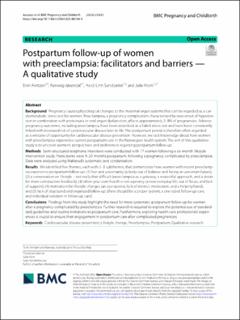| dc.description.abstract | Background
Pregnancy causes physiological changes to the maternal organ systems that can be regarded as a cardiometabolic stress test for women. Preeclampsia, a pregnancy complication characterized by new onset of hypertension in combination with proteinuria or end-organ dysfunction, affects approximately 2–8% of pregnancies. Adverse pregnancy outcomes, including preeclampsia, have been described as a failed stress test and have been consistently linked with increased risk of cardiovascular disease later in life. The postpartum period is therefore often regarded as a window of opportunity for cardiovascular disease prevention. However, we lack knowledge about how women with preeclampsia experience current postpartum care in the Norwegian health system. The aim of this qualitative study is to uncover women’s perspectives and preferences regarding postpartum follow-up.
Methods
Semi-structured telephone interviews were conducted with 17 women following a six-month lifestyle intervention study. Participants were 9–20 months postpartum, following a pregnancy complicated by preeclampsia. Data were analyzed using Malterud’s systematic text condensation.
Results
We identified five themes, each with 2–3 subthemes, that demonstrate how women with recent preeclampsia experience postpartum follow-up: (1) fear and uncertainty (a body out of balance and facing an uncertain future), (2) a conversation on lifestyle – not really that difficult (preeclampsia as a gateway, a respectful approach, and a desire for more constructive feedback), (3) when your own health is not a priority (a new everyday life, out of focus, and lack of support), (4) motivation for lifestyle changes (an eye opener, lack of intrinsic motivation, and a helping hand), and (5) lack of structured and organized follow-up (there should be a proper system, a one-sided follow-up care, and individual variation in follow-up care).
Conclusions
Findings from this study highlight the need for more systematic postpartum follow-up for women after a pregnancy complicated by preeclampsia. Further research is required to explore the potential use of standardized guidelines and routine invitations to postpartum care. Furthermore, exploring health care professionals’ experiences is crucial to ensure their engagement in postpartum care after complicated pregnancies. | en_US |

